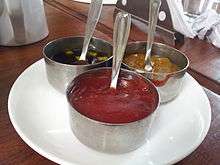Chutney
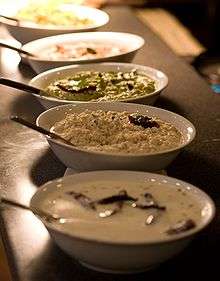 | |
| Alternative names | Chatney, Chatni, Satni |
|---|---|
| Place of origin | Indian subcontinent |
| Region or state | India |
| Main ingredients | Seasonings such as salt, spices/herbs, and vegetables/fruits such as chilis, Damsons, plums, tomatoes, apple, pear, onion, garlic, fig, etc. The nearest bowl to the viewer is a dahi chutney, based on yoghurt (dahi). |
 Dakshin (south) style chutney (green one in the middle) |
 Chutneys |
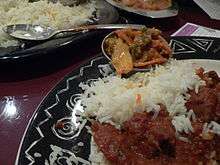 Mango chutney |
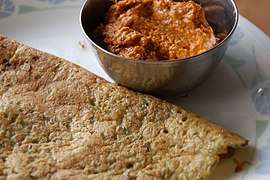 Pesarattu and ginger chutney |
Chutney is a sauce or a dry base for a sauce in the cuisines of India that can include such forms as a spicy coconut dip, a tomato relish, a ground peanut garnish or a dahi (yogurt), cucumber, and mint dip.
An offshoot that took root in Anglo-Indian cuisine is usually a tart fruit such as sharp apples, rhubarb or damson pickle made milder by an equal weight of sugar (usually demerara or brown sugar to replace jaggery in some Indian sweet chutneys). Vinegar was added to the recipe for English-style chutney that traditionally aims to give a long shelf life so that autumn fruit can be preserved for use throughout the year (as are jams, jellies and pickles) or else to be sold as a commercial product. Indian pickles use mustard oil as a pickling agent, but Anglo-Indian style chutney uses malt or cider vinegar which produces a milder product that in western cuisine is usually eaten with a Cheddar-type cheese or with cold meats and fowl, typically in cold pub lunches.[1][2]
Nowadays, the making of some pickles and chutneys in India has been passed over to commercial production, whereas at one time it was done entirely in people's homes. The disadvantage of commercial chutneys and those produced in western style with vinegar and large amounts of sugar is that the main aim of sugar and vinegar as preservatives is to make the product safe for long-term consumption. Regular consumption of these products (as distinct from the original Indian array of fresh relishes) can add to total sugar consumption being increased to unhealthy levels.[3]
Etymology
The word "chutney" is derived from the Hindi word चटनी chaṭnī, meaning to lick. In India, "chutney" refers to fresh and pickled preparations indiscriminately. Several Indian languages use the word for fresh preparations only. A different word achār (Hindi: अचार) applies to pickles that often contain oil and are rarely sweet.
Overview
In India, chutneys can be either made alongside pickles that are matured in the sun for up to two weeks and kept up to a year or, more commonly, are freshly made from fresh ingredients that can be kept a couple of days or a week in the refrigerator.
In Tamil Nadu, thogayal or thuvayal (Tamil) are preparations similar to chutney but with a pasty consistency. In Andhra Pradesh it is also called roti pacchadi. In Telangana the same are called tokku.
Medicinal plants that are believed to have a beneficial effect are sometimes made into chutneys, for example Pirandai Thuvayal[4] or ridged gourd chutney (Peerkangai Thuvayal or beerakaaya tokku).[5] Ridged gourd can be bought in Chinese and Indian shops in large towns in the west.[6] and, when dried, becomes a bath sponge known as a luffa or loofah.
Bitter gourd can also serve as a base for a chutney which is like a relish[7][8] or, alternatively as a dried powder.[9]
Occasionally, chutneys that contrast in taste and colour can be served together—a favourite combination being a green mint and chili chutney with a contrasting sweet brown tamarind and date chutney.[10][11][12][13]
Chutneys may be ground with a mortar and pestle or an ammikkal (Tamil). Spices are added and ground, usually in a particular order; the wet paste thus made is sautéed in vegetable oil, usually gingelly (sesame) or peanut oil. Electric blenders or food processors can be used as labor-saving alternatives to stone grinding.
American and European-style chutneys are usually fruit, vinegar, and sugar cooked down to a reduction, with added flavourings. These may include sugar, salt, garlic, tamarind, onion or ginger.[14] Western-style chutneys originated from Anglo-Indians at the time of the British Raj recreated Indian chutneys using English orchard fruits—sour cooking apples and rhubarb, for example. They would often contain dried fruit: raisins, currants and sultanas.
They were a way to use a glut of fall fruit and preserving techniques were similar to sweet fruit preserves using approximately an equal weight of fruit and sugar, the vinegar and sugar acting as preservatives.
South Indian chutney powders are made from roasted dried lentils to be sprinkled on idlis and dosas.[15] Peanut chutneys can be made wet or as a dry powder.[16][17]
Spices commonly used in chutneys include fenugreek, coriander, cumin and asafoetida (hing). Other prominent ingredients and combinations include cilantro, capsicum, mint (coriander and mint chutneys are often called हरा hara chutney, Hindi for "green"), Tamarind or Imli (often called meethi chutney, as मिठाई meethi in Hindi means "sweet"), sooth (or saunth, made with dates and ginger), coconut, onion, prune, tomato, red chili, green chili, mango, lime (made from whole, unripe limes), garlic, coconut, peanut, dahi, green tomato, dhaniya pudina (cilantro and mint), peanut (shengdana chutney in Marathi), ginger, dahi (yogurt), red chili powder, tomato onion chutney,[18] cilantro, and mint coconut chutney[19] and apricot.[20]
Major Grey's Chutney is a type of sweet and spicy chutney popular in the United States. The recipe was reportedly created by a 19th-century British Army officer of the same name (likely apocryphal) who presumably lived in Colonial India. Its characteristic ingredients are mango, raisins, vinegar, lime juice, onion, tamarind extract, sweetening and spices. Several companies produce a Major Grey's Chutney, in India, the UK and the US.
History
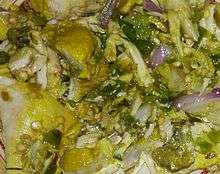
Similar in preparation and usage to a pickle, simple spiced chutneys can be dated to 500 BC. Originating in India,[21] this method of preserving food was subsequently adopted by the Romans and later British empires, who then started exporting this to the colonies, Australia and North America.
As greater imports of foreign and varied foods increased into northern Europe, chutney fell out of favor. This combined with a greater ability to refrigerate fresh foods and an increasing amount of glasshouses meant chutney and pickle were relegated to military and colonial use. Chutney reappeared in India around the 1780s as a popular appetizer.
Diego Álvarez Chanca brought back chili peppers from the Americas to Spain in 1493. He had sailed with Columbus. After discovering their medicinal properties, Chanca developed a chutney to administer them.
In the early 17th century, British colonization of the Indian subcontinent relied on preserved food stuffs such as lime pickles, chutneys and marmalades. (Marmalades proved unpopular due to their sweetness. They were also rare due to a lack of available sugar.)
Beginning in the 17th century, fruit chutneys were shipped to European countries such as England and France as luxury goods. These imitations were called "mangoed" fruits or vegetables, the word 'chutney' still being associated with the lower working classes.
Major Grey's Chutney is thought to have been developed by a British officer who had traveled to India. The formula was eventually sold to Crosse and Blackwell, a major British food manufacturer, probably in the early 1800s.[22] In the 19th century, types of chutney like Major Grey's or Bengal Club created for Western tastes were shipped to Europe from Monya.
Generally these chutneys are fruit, vinegar, and sugar cooked down to a reduction.
The tradition of chutney making spread through the English-speaking world, especially in the Caribbean and American South, where chutney is a popular condiment for ham, pork, and fish.
By regions of India
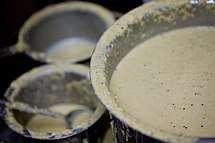
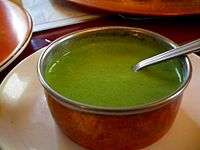
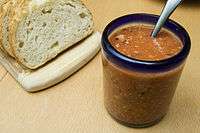
| Region | Chutneys |
|---|---|
| Assam | Coriander, spinach, tomato chutney, curry leaf, chili, radish, carrot, cucumber, beetroot, lentil, chickpea, ghost chilli pepper chutneys |
| Andhra Pradesh | Peanut, coconut chutney, coriander, red chilli with grams (chana), tomato, onion, lemon, curry leaf, tamarind, green chilli, ginger, mint, mango chutneys |
| Gujarat | Hot lime chutneys, garlic chutney |
| Haryana | Onion garlic chilli chutney, kachri chutney (small wild muskmelon), hara choley chutney (unripe young green chickpea), pudina chutney, tomato chutney, potato chutney |
| Himachal Pradesh | Guava and eggplant chutneys |
| Karnataka | Coconut chutney, chilli, peanut, tomato, tamarind, mango, urid dal, pudina (mint), heeray kayi (ridge gourd),badane kayi (eggplant), uchellu (Niger seed), bende kaayi (okra or ladyfinger), agashi (flax seed), ginger chutneys |
| Kerala | Coconut chutney, mint, urad dal, mango, dry fish, shrimp, onion chutney |
| Maharashtra | Hot raw mango chutney, coconut chutney, muramba, panchamrit, mirachicha thecha: dry chutneys made oil seeds such as with javas (flax seed), Solapuri shenga (peanut/red chili powder), karale (Niger seed), peanut/garlic (lasun), dudhi (roasted Dudhi (bottle gourd) skin chutney), tamarind chutney |
| Odisha | Coconut, mango, orange, tomato, dried fish chutneys |
| Punjab | Pudina (mint) chutney, onion chutney, tamarind chutney, mango chutney |
| Tamil Nadu | Coconut chutney, coriander, curry leaf, red chilli, green chilli, garlic, peanut, tamarind, tomato, onion, ginger, radish, mint, mango, lentil chutneys |
| Telangana | Coconut chutney, peanut, tomato, lemon, curry leaf, tamarind, green chilli, ginger, mint, mango chutneys |
| Uttar Pradesh and Bihar | Coriander seed and leaf, garlic, roasted onion, cooked tomato, mint, radish, amla, sweet and sour mango, green chili, boiled potato and pickled mango, red chili and jaggery chutneys |
| Uttarakhand | Bhanga (cannabis) chutney |
| West Bengal | Amla (gooseberry), coriander, lime, green mango, tomato, papaya, pineapple, date, dried mango jelly and other dry fruits, green chili chutneys |
See also
- Anglo-Indian cuisine – for a divergent type of chutney in the UK and elsewhere
- Branston Pickle
- Piccalilli
- Dahi chutney – a yoghurt-based side dish classed as a chutney
- Furikake – a dry, coarsely powdered Japanese food eaten similarly to dry chutney
- Indian pickle
- Sooth (chutney)
- Pickling
- Relish
- Condiment
- Sauce
- Dip
- Sauerkraut
- List of ancient dishes and foods
- List of chutneys
- List of condiments
- List of dips
References
- ↑ "Chutney of Empire". hardylane.blogspot.se. Retrieved 27 October 2017.
- ↑ Bateman, Michael (18 August 1996). "Chutneys for relishing". The Independent. Retrieved 27 October 2017.
- ↑ "2.2. Selecting products and production methods". www.fao.org. Retrieved 27 October 2017.
- ↑ "Pirandai Thuvayal". Archived from the original on 4 March 2016. Retrieved 27 October 2017.
- ↑ Padhu. "Peerkangai Thogayal-Ridge Gourd Chutney (thuvayal) Recipe". Retrieved 27 October 2017.
- ↑ Kaveri Venkatesh (2013-07-07). "Palakkad Chamayal: Thengai Thogayal". Palakkadcooking.blogspot.se. Retrieved 2017-10-27.
- ↑ "Hagalakayi Chutney / Bitter gourd chutney". Smithakalluraya.com. Retrieved 27 October 2017.
- ↑ "Kakarkaya Pachadi / Bitter Gourd Chutney". edivyaraj.blogspot.se. Retrieved 27 October 2017.
- ↑ M., Chebbi, Deepak. "Recipes - Bitter Gourd Chutney Powder". yousigma.com. Retrieved 27 October 2017.
- ↑ "Date And Tamarind Chutney/ Coriander And Mint Chutney » DivineTaste". www.divinetaste.com. Retrieved 27 October 2017.
- ↑ "Khajur Imli ki Chutney recipe - Imli ki Chutney Recipes - by Tarla Dalal - Tarladalal.com - #2796". www.tarladalal.com. Retrieved 27 October 2017.
- ↑ "green chutney recipe, how to make punjabi green chutney recipe". www.vegrecipesofindia.com. Retrieved 27 October 2017.
- ↑ Admin. "How to make Green Chutney & Sweet Chutney for Chats : ( Mint Chutney ) / ( Date & Tamarind Chutney ) / Chutneys for Chats:". www.tastyappetite.net. Retrieved 27 October 2017.
- ↑ Jellies, Jams & Chutneys, Prince, Thane. Jellies, Jams & Chutneys. Penguin.
- ↑ "Dry Chutney Powders - Simple Indian Recipes". simpleindianrecipes.com. Retrieved 27 October 2017.
- ↑ "Peanut Chutney Recipe - South Indian Style Chutney for Dosa and Idli". Retrieved 27 October 2017.
- ↑ "PEANUT CHUTNEY POWDER / SHENGA CHUTNEY PUDI". Retrieved 27 October 2017.
- ↑ "Tomato Onion chutney « Sinful Curry". sinfulcurry.com.
- ↑ "Cilantro Mint Coconut Chutney « Sinful Curry". sinfulcurry.com.
- ↑ Sara Buenfeld (1 February 2008). "Apricot blatjang". BBC Good Food.
- ↑ Raghavan, S. (2006). Handbook of Spices, Seasonings, and Flavorings, Second Edition. CRC Press. p. 255. ISBN 978-1-4200-0436-6. Retrieved October 30, 2017.
- ↑ Helstosky, C. (2014). The Routledge History of Food. Routledge Histories. Taylor & Francis. p. 330. ISBN 978-1-317-62113-3. Retrieved 2017-10-27.
Further reading
- Weaver, William Woys. "Chutney". Encyclopedia of Food and Culture. Ed. Solomon H. Katz. Vol. 1. New York: Charles Scribner's Sons, 2003. 417–418. 3 vols. ISBN 0-684-80568-5.
- Dahiya, Ashish. Food of Haryana: The Great Chutneys Vol. 1. India. ISBN 978-93-81818-05-3.
- Food Safety in Production of Chutney, Pickles. Jams, Oils – UK
External links
| Wikimedia Commons has media related to Chutney. |
- Chutney Origins. Foodreference.com.



